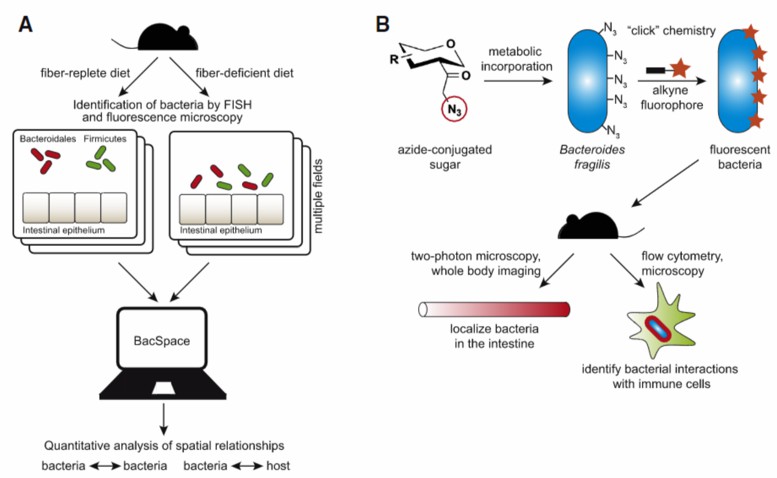Human gastrointestinal tracts are colonized with a vast universe of microorganisms that form communities specific to different people and profoundly affect human physiology. The gut microbiota is deemed to play pivotal roles in maintaining host health, as well as involved in many pathogenesis procedures, which attracts people's attention and more and more studies have been focusing on gut microbiota. Modern methods characterize the communities of gut microbiota by using culture-independent techniques including next-generation sequencing, microarray, and mass spectrometry. These techniques operate through the measurement of either genomic content or other biological molecules rather than through direct analysis of cells. While fluorescence in situ hybridization (FISH) proposes a rather different strategy that provides the visualization of the cells as well as the determination of relative abundances of target taxa.
FISH technology combines the precision of molecular biology with the visibility of the microscopy to monitor and identify different microbial individuals in gut microbiota samples. It targets the most stable rRNA (mainly 16S and 23S) among microorganisms as the analysis target, designs probes with rRNA sequence for hybridization, and conducts identification and quantitative analysis of detected microbial distribution and characteristic microorganisms. FISH technology uses nucleic acid probes to directly detect homologous nucleic acid sequences in solution, in cell tissues, or fixed on membranes. Thousands of species of microorganisms can be identified as well as quantitative and qualitative analysis of their existence, distribution, abundance, and adaptability, providing abundant information such as microbial morphology, spatial distribution, and the number of microorganisms.
CD Genomics is a preeminent corporation that specializes in multi-omics. Equipped with state-of-the-art techniques and served by well-experienced scientists, CD Genomics provides one-stop services for your gut microbiota research. Thus, we also offer fluorescence in situ hybridization services to compensate for NGS, microarray, MS, etc. We have rich experience in FISH-based microbiological detection and identification and provide extensive microbial detection probes and corresponding in situ hybridization services.
Figure 1. A brief view of the FISH process for visualizing and tracking the microbiota (Propheter 2015)
We provide complete fluorescence in situ hybridization services to satisfy your needs:
◆ Sample pretreatment
◆ Probe design and synthesis
◆ Conduct fluorescence in situ hybridization experiment
◆ Imagery processing
◆ Results analysis and project report
CD Genomics is one of the most trusted companies in the field. We are committed to providing the best strategies for your gut microbiota and related studies, and offering the most appropriate strategies for your samples and research purposes. Our gut microbiota fluorescence in situ hybridization services have the advantages of accurate and rapid microbial detection, available for various sample types, and custom services according to your requirements. With a wide range of multi-omics and other supplementary technologies, we have helped many researchers make progress in the gut microbiota projects. We dedicate to saving your precious time and laboring and improving efficiency for your project. We are looking forward to cooperating with you. If you have any questions, please feel free to contact us.
References
1. Mark Welch JL; et al. Spatial organization of a model 15-member human gut microbiota established in gnotobiotic mice. Proceedings of the National Academy of Sciences. 2017, 114(43): E9105.
2. Propheter DC; Hooper LV. Bacteria come into focus: new tools for visualizing the microbiota. Cell host & microbe. 2015;18(4):392-4.
3. Earle KA; et al. Quantitative imaging of gut microbiota spatial organization. Cell host & microbe. 2015, 18(4): 478-88.
*For Research Use Only. Not for use in diagnostic procedures.


